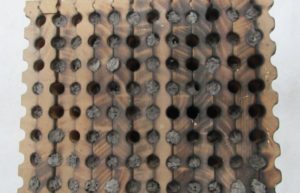Tim started harvesting his mason bee cocoons from his wooden trays last week using our fabulous SCOOP. He emailed me this photo showing a very good harvest. 60 cocoons in just one layer.
See what your harvest looks like per female cocoon. And see what your mite infestation is to tell you how well you removed mites from cocoons before setting them out in the spring.
HARVEST RESULTS
In spring before setting cocoons out, count the number of total cocoons. This will help in calculating if your harvest is a good one.
Total at site in spring = 600 or 300 females ( about half of total)
Tot cocoons harvested = 1540
Lets look at the numbers:
Each female produced 1540/300 or 5 offspring. Nothing wrong with this production.
MITES
Before removing all the cocoons, count the total number of cells with or without cocoons
TOTAL CELLS with cocoons and CELLS WITH MITES
8 and 0 (First tunnel at the top)
9 and 0
9 and 1
9 and 2
9 and 0
7 and 0
10 and 0
2 and 0
_________
63 and 3
Number of cells with mites/ total cells x 100 = Percent of mite infested cells
or 3/63 = 4.76%
If the percentage of mite infested cells is less than about 5%. You have done a good job of cleaning mites of cocoons and nests.
In this case mite infested cells is 4.76 %
%
Good job Tim!

Jim Fishwick
Regarding the number of mites in a tray, you seem to be suggesting that it is lack of proper cleaning that would produce mite problems. I can certainly understand that. However I thought mites were in the environment and my bee’s could always pick up some new ones during the season regardless of how well they were cleaned. I would appreciate your comment on this. Thank You.
margriet dogterom
both are true. you can never get mites out of the environment entirely, but if you don’t clean actively, they’ll multiply and gather together until they run of of food. Keep that particular part of nature from overwhelming the part you wish to propagate; that’s what I meant by ‘a numbers game’